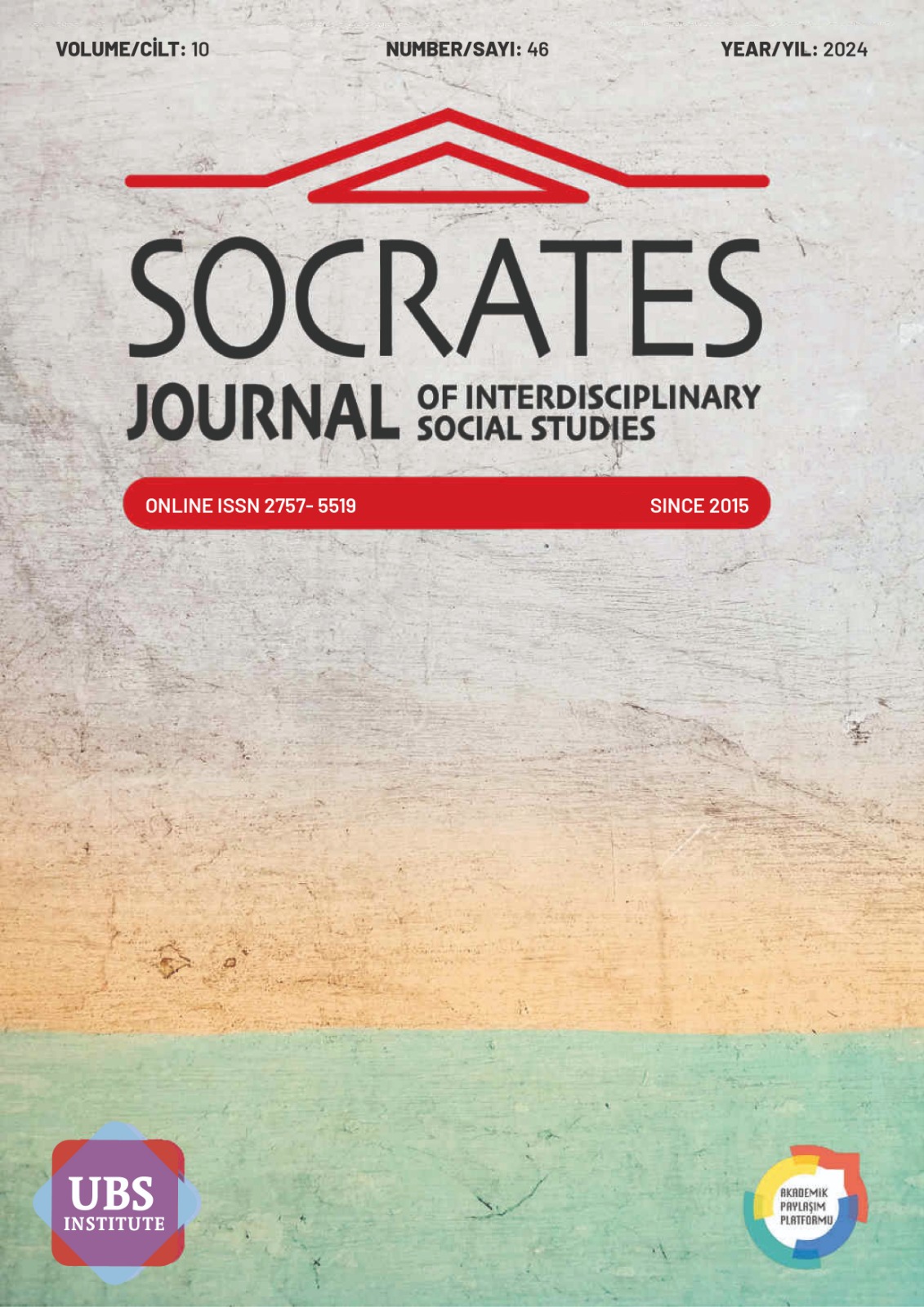EĞİTİM BİLİMLERİ ALANINDA YAPAY ZEKÂ KONULU BİLİMSEL YAYINLARIN EĞİLİMLERİ: BİBLİYOMETRİK BİR İNCELEME
TRENDS IN SCIENTIFIC PUBLICATIONS ON ARTIFICIAL INTELLIGENCE IN EDUCATIONAL SCIENCES: A BIBLIOMETRIC ANALYSIS
DOI:
https://doi.org/10.5281/zenodo.13981118Keywords:
Artificial Intelligence, Education, Bibliometric AnalysisAbstract
This study aims to examine the trends of scientific publications on artificial intelligence (AI) in the field of educational sciences from a bibliometric perspective. The bibliometric analysis method examines the general trends among scientific publications and the relationships between these publications through the data in the literature. Artificial intelligence has great potential for improving individualized learning and educational management in education. In the literature, the number of studies on the use of artificial intelligence in education shows an increasing trend. In this context, the current study analyzed the relationships between the productivity, citation performance, author collaborations, countries of publication and keywords of scientific studies on artificial intelligence and education. The metadata used in the research were obtained from the Web of Science database. Bibliometric mapping analysis was performed using VOSviewer software. The findings show that research on artificial intelligence is concentrated especially in China and the USA, and keyword analysis shows that themes such as “machine learning”, “student performance” and “educational management” come to the fore. The increasing importance of AI in education and the opportunities offered by this technology constitute a important research area for future studies.
References
Abed, R. Q., Dikmen, M., Aydemir, E., Barua, P. D., Dogan, S., Tuncer, T., ... & Acharya, U. R. (2024). Automated reading level classification model based on improved orbital pattern. Multimedia Tools and Applications, 83(17), 52819-52840.
Al, U., & Tonta, Y. (2004). Atıf analizinin kurumsal değerlendirme ve bilim politikalarındaki yeri. Bilgi Dünyası, 5(1), 1-17.
Andrade, J., Heitor, M., & Mendonca, J. (2017). Bibliometric analysis in emerging science fields: A case study of technology-enhanced learning research. Scientometrics, 112(3), 1411-1447. https://doi.org/10.1007/s11192-017-2313-8.
Arslan, K. (2020). Eğitimde yapay zekâ ve uygulamaları. Batı Anadolu Eğitim Bilimleri Dergisi, 11(1), 71-88.
Chen, C. M., Wang, J. Y., & Yu, C. M. (2017). Assessing the attention levels of students by using a novel attention aware system based on brainwave signals. British Journal of Educational Technology, 48(2), 348-369.
Dikmen, S. (2024). Öğrencilerin Derse Yönelik Dikkatlerini Anlık Olarak Ölçen Yapay Zekâ Yazılımının Geliştirilmesi [Doktora tezi, Fırat Üniversitesi]. Fırat Üniversitesi Eğitim Bilimleri Enstitüsü.
Ellegaard, O., & Wallin, J. A. (2015). The bibliometric analysis of scholarly production: How great is the impact? Annual Review of Information Science and Technology, 49(1), 55-95. https://doi.org/10.1002/aris.2014.1440490115.
Fahimnia, B., Sarkis, J., & Davarzani, H. (2015). Green supply chain management: A review and bibliometric analysis. International Journal of Production Economics, 162, 101-114. https://doi.org/10.1016/j.ijpe.2015.01.003.
Good, T. L., & Beckerman, S. (1978). Teacher behavior and student attention in instructional settings. Review of Educational Research, 48(4), 609-629.
Gür, B., & Katrancı, M. (2019). Dikkat ve Bilinç. Türk Psikoloji Yazıları, 22(44), 1-10.
Hallinger, P., & Suriyankietkaew, S. (2018). A bibliometric review of research on sustainable leadership, 1990–2018. Sustainability, 10(2), 484. https://doi.org/10.3390/su10020484.
Hinojo-Lucena, F., Díaz, I., Cáceres-Reche, M., & Rodríguez, J. (2019). Artificial intelligence in higher education: A bibliometric study on its impact in the scientific literature. Education Sciences, 9(1), 51. https://doi.org/10.3390/educsci9010051.
Hudson, J. (1996). Trends in multi-authored papers in economics. Journal of Economic Perspectives, 10(3), 153-158.
Kurtz, M. J., & Bollen, J. (2010). Usage bibliometrics. Annual Review of Information Science and Technology, 44(1), 3-64. https://doi.org/10.1002/aris.2010.1440440108.
Lis, A., & Tomanek, M. (2021). Mapping the intellectual and conceptual structure of physical education research: Direct citation analysis. Physical education of students, 25(2), 67-84.
Öztürk, M., & Şahin, E. (2018). Yapay zekâ ve eğitim. Journal of Artificial Intelligence Research and Development, 1(1), 1-10.
Panigrahi, C. M. A. (2020). Use of artificial intelligence in education. Management Accountant, 55, 64-67.
Pritchard, A. (1969). Statistical bibliography or bibliometrics? Journal of Documentation, 25(4), 348-349.
Salini, S. (2016). Statistical analysis of bibliometric data: A review. Scientometrics, 107(3), 1145-1165. https://doi.org/10.1007/s11192-016-1913-7.
Small, H. (1973). Co-citation in the scientific literature: A new measure of the relationship between two documents. Journal of the American Society for Information Science, 24(4), 265-269.
Steenbergen-Hu, S., & Cooper, H. (2014). A Meta-analysis of the effectiveness of intelligent tutoring systems on college students' academic learning. Journal of Educational Psychology, 106(2), 331-347.
Şahin, A., Karakaya, Y. E., & Dikmen, S. (2023). Mapping tendencies in curriculum research on physical education and sports: A bibliometric analysis. Participatory Educational Research (PER), 10(3), 106-129.
Karakaya, Y. E., Dikmen, M., & Şahin, A. (2023). Bibliometric mapping of research trends in education, physical education, and sports for the disabled. Life Span and Disability, 1 (2023), 53-92
Tuncer, M., Dikmen, M., & Vural, M. (2022). Dijital Oyun Bağımlılığı, Davranış Problemleri ve Akademik Performans: Bibliyometrik Bir Haritalama. Sosyal, Beşeri ve İdari Bilimler Dergisi, 5(7), 913-933.
Van Eck, N. J., & Waltman, L. (2010). Software survey: VOSviewer, a computer program for bibliometric mapping. Scientometrics, 84(2), 523-538. https://doi.org/10.1007/s11192-009-0146-3.
Van Eck, N. J., & Waltman, L. (2014). Visualizing bibliometric networks. In Y. Ding, R. Rousseau, & D. Wolfram (Eds.), Measuring scholarly impact (pp. 285-320). Springer. https://doi.org/10.1007/978-3-319-10377-8_13.
Villa, R. (2020). Artificial intelligence and attention tracking in education: A new frontier for learning. Educational Technology & Society, 23(2), 123-135.
Zupic, I., & Cater, T. (2015). Bibliometric methods in management and organization. Organizational Research Methods, 18(3), 429-472. https://doi.org/10.1177/1094428114562629.
Downloads
Published
How to Cite
Issue
Section
License
Copyright (c) 2024 Socrates Journal of Interdisciplinary Social Studies

This work is licensed under a Creative Commons Attribution 4.0 International License.


